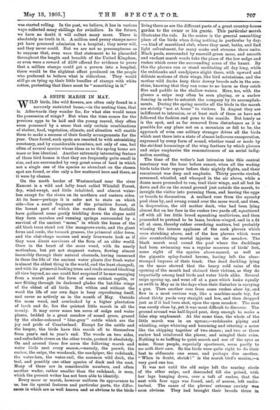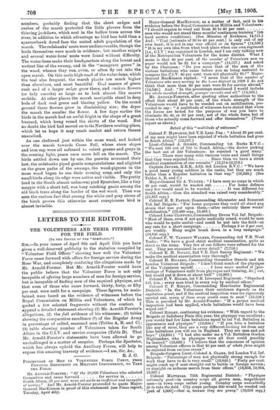A SNIPE MARSH IN MAY.
On the north border of Westmorland near the river Eamont is a wild and lofty tract called Whinfell Forest, dry, wind-swept, and little inhabited, and almost water- less except for the rivers on its northern and eastern sides. At its base—perhaps it is safer not to state on which side—lies a small fragment of the primitive forest, at the lowest part of which the waters that the foothills have gathered come gently trickling down the slopes until they form marshes and running springs surrounded by a survival of the ancient "moss," in which the knees of the old birch trees stand out like mangrove-roots, and the giant ferns and reeds, the tussock grasses, the primeval alder trees, and the club-shape mosses and scaly liverworts look as if they were direct survivors of the flora of an older world. Once in the heart of the moss wood, with its nearly motionless, but yet not stagnant waters, flowing almost insensibly through their natural channels, having immersed in them the life of the ancient water plants (for fresh water is almost the oldest thing in the world, and the least changed), and with its primeval-looking trees and reeds around blocking all view beyond, no one could feel surprised if he saw emerging from a. marsh pool the form of some extinct reptile, or saw flitting through its darkened glades the bat-like wings of the oldest of all birds. But within and without the wood the life of our own days is busy reproducing itself, and never so actively as in the month of May. Outside the moss wood, and overlooked by a higher plantation of larch and fir, lies the quietest little marsh in all the county. It may cover some ten acres of sedge and water plants, bedded in a great meadow of sound grass, grazed by the cinder-coloured " blue-grey " cattle which are the joy and pride of Cumberland. Except for the cattle and the keeper, the birds have this marsh all to themselves from year's end to year's end. The woods on two sides, and unfordable rivers on the other twain, protect it absolutely. On and around these few acres the following marsh and water birds nest every season,—namely, the peewit, the curlew, the snipe, the woodcock, the sandpiper, the redshank, the water-hen, the water-rail, the common wild duck, the teal, and possibly one other species of duck and the coot. Many of these are in considerable numbers, and often another wader, rather smaller than the redshank, is seen, which the present writer has not been able to identify.
Every moor or marsh, however uniform its appearance to us, has its special features and particular parts, the differ- ences in which are as well known and as obvious to the birds living there as are the different parts of a great country-house garden to the owner or his guests. This particular marsh illustrates the rule. In the centre is the general assembling place of the birds when doing nothing in particular by day, —a kind of marshland club, where they meet, bathe, and find light refreshment, for many soaks and streams there unite. Black pools, surrounded by emerald-green moss, and smooth and verdant marsh weeds take the place of the low sedge and rushes which cover the surrounding acres of the haunt. By this the plovers run or stand meditating all day long, while the redshanks and sandpipers alight there, with upward and delicate motions of their wings, like bird salutations, and the mother wild ducks keep their downy broods safe in the sun- shine, knowing that they can come to no harm as they catch flies and paddle in the shallow waters. Here, too, with the glasses a snipe may often be seen playing, or a curlew dancing in order to astonish the company by its accomplish- ments. During the spring months all the birds in the marsh are strictly "not at home" to visitors. In August they are indifferent to intrusion, or at least such of them as have not followed the fashion and gone to the seaside. But lonely as is the spot, and as far removed from disturbance as it is possible for any place not on a mountain or fell to be, the approach of even one solitary stranger drives all the birds which nest there into a state of almost ludicrous exasperation, expressed by every form of sound, whether vocal or made by the strident hummings of the wing feathers by which plovers and snipe emphasise the remonstrances of an aerial indig- nation meeting.
The time of the writer's last intrusion into this central sanctuary was the hour before sunset, when all the wading birds take their repose before their nightly flights, and their resentment was deep and emphatic. Thirty peewits circled, screamed, whistled, and whooped in the air above, while a dozen more proceeded to run, trail their wings, and all but lie down and die on the sound ground just outside the marsh, to inveigle the visitor into pursuing them, and leaving the eggs or broods to themselves. A mallard rose from the squashy pool close by, and swung round over the moss wood, and then, in desperation, the old mother duck, who had been lying almost flat on her face in the rushes two yards off, squattered off with all her little brood squeaking multivious, and then proceeded to pretend to be lame, broken-winged, and in a fit all at once, thereby rather overdoing matters, but probably winning the intense applause of the cock plovers Which were shrieking above, and of the hen plovers which were also counterfeiting mortal injuries on the meadow. The black marsh mud round the pool where the ducklings had been swimming was a regular museum of birds' feet, some eight of the species above-named, as well as the gigantic splay-footed herons, having left the clear- stamped impress of their track. One dead duckling lying on the moss showed that the heavy cold rains of the opening of the month had claimed their victims, as they do impartially among land birds and water birds alike. Several snipe sprang up, and went off at a pace which looks equally as swift in May as in the days when their disturber is carrying a gun. Then another rose from some rushes close by, and flew in a most curious way, like a machine-made toy, for about thirty yards very straight and low, and then dropped just as if it had been shot, upon the open meadow. The nest was surely close by, yet it was most difficult to discover. The ground around was half-liquid peat, deep enough to make a false step unpleasant. At the same time, the whole of the little marsh was in an uproar,—redshanks piping and whistling, snipe whirring and humming and uttering a noise like the chipping together of two stones; and two or three curlew had reinforced the plover, and mingled their cries. Nothing is so baffling to quiet search and use of the eyes as noise. Some people, especially sportsmen, seem partly to see with their ears. So the birds were quite right to do their best to obfuscate one sense, and perhaps dim another. "When in doubt, shriek I" is the marsh bird's maxim,—a very good one too.
It was not until the old snipe left the soaring circle of the other snipe, and descended till she poised, with her legs hanging down, over a tuft of rushes, that the neat with four eggs was found, and, of course, left undis- turbed. The cause of the plovers' extreme anxiety was soon obvious. They had brought their broods there in
numbers, probably finding that the short sedges and rushes of the marsh protected the little plovers from the thieving jackdaws, which nest in the hollow trees across the river, in addition to which advantage no bird less bold than a sparrowha.wk dared face the united adult population of the marsh. The redshanks' nests were undiscoverable, though the birds themselves were much in evidence ; but another snipe's and several water-hens' nests were found without difficulty. The water-hens make their headquarters along the lowest and wettest line of the swamp, and in the "mangrove grove" in the wood, whence they run, swim, or often fly out into the open marsh. On this main high-road of the water-hens, which the teal also frequent, the marsh plants are much higher than elsewhere, and most beautiful. Cool masses of green rush and of a larger sedge grow there, and cuckoo. flowers (or lady smocks) so large as to look almost like mauve orchids. At other places the marsh marigolds stand in deep beds of dark cool green and blazing yellow. On the sound ground these flowers grow in diminishing size ; the dryer the marsh the smaller the flower. A few days earlier the birds in the marsh had an awful fright in the shape of a great buzzard, which hung round the skirts of the wood. But no doubt the bird had moved on to its Northern nesting-place, which let us hope it may reach unshot and return thence unscathed.
As one sheltered just within the moss wood, and looked over the marsh towards Cross Fell, whose stern slopes and iron cap were all softened to velvet greens and greys in the evening light, peace once more fell on the marsh. The birds settled down one by one, the peewits screamed their last, the redsbanks piped gentle congratulations and alighted on the grass paths of the swamps, the wood-pigeons in the moss wood began to coo their evening song, and only the small birds along its edge were active and visible. The pretty (and in the South almost unknown) pied flycatcher, like a tiny magpie with a short tail, was busy catching gnats among the old birch trees along the border of the wet wood. Then was seen the curious fact that among the white and grey stems of the birch groves this otherwise most conspicuous bird is almost invisible.







































 Previous page
Previous page